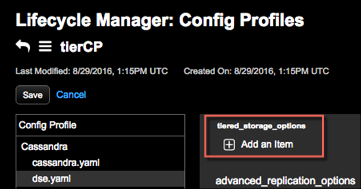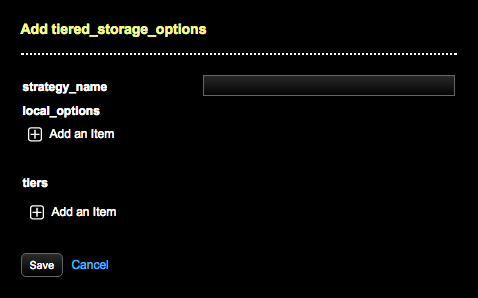Configure tiered storage using LCM
DSE Tiered Storage segregates hot and cold data to designated paths on different gradations of storage media, which can facilitate cost savings for data storage.
Configure the storage tier strategy and paths to each tier in dse.yaml within an Lifecycle Manager (LCM) configuration profile.
Run an install or configure job in LCM to push the configuration to all applicable nodes.
Procedure
-
Click Config Profiles from the Lifecycle Manager navigation menu.
-
Click the edit icon for the configuration profile to edit, or click Add config profile if you have not already created a profile.
-
In the Config Profile pane under the Cassandra section, click dse.yaml.
-
Scroll down to the Miscellaneous pane and locate
tiered_storage_options.
-
Click + Add an item under the
tiered_storage_optionsoption. -
Enter a
strategy_name.For DSE clusters to use the tiered storage strategy, the strategy must be referenced in the
configof the table schema. See Configure DSE Tiered Storage.
-
Optional Under local_options, click Add an item to add local configuration options to overwrite the tiered storage settings in the table schema.
The class or the tiered storage configuration name cannot be overwritten. For more details and an example, see Test DSE Tiered Storage configurations.
-
Enter a key and value for each local option. For example, type
max_tier_agesforkeyand3600for itsvalue. -
Click Save.
-
-
Under tiers, click + Add an item to define the paths to the storage tiers.
-
Enter the paths to the directory for each tier in the strategy.
Tier order of each path matters. Add the paths for each tier in the order that represents each successive tier in a strategy. Each tier added is used in the order listed, with the top tier typically routing data to the fastest storage media.
Ensure the directories referenced in the path already exist. LCM does not create the directories. If the directories do not exist when the installation or configuration job runs, DSE does not start up.
-
Click Save to add the strategy and tiers to the configuration profile.
-
-
Click Save to save the Config Profile.
Next steps
-
Apply tiered storage to a table schema using
CREATEorALTERtable statements, and define the maximum age of data in each tier. See Configure DSE Tiered Storage and Test DSE Tiered Storage configurations for complete details.CREATE TABLE ks.tbl (k INT, c INT, v INT, PRIMARY KEY (k, c)) WITH COMPACTION={'class':'org.apache.cassandra.db.compaction.TieredCompactionStrategy', 'tiering_strategy': 'TimeWindowStorageStrategy', 'config': 'strategy1', 'max_tier_ages': '3600,7200'}; -
Go to the Clusters workspace in Lifecycle Manager and select the configuration profile to apply at the cluster, datacenter, or node level. Nodes can inherit configuration profile settings from the cluster or datacenter levels, or have settings at the node level that take precedence.
-
Run a configuration job to push the configuration to all of the applicable nodes.
-
Add dashboard graphs and alerts to monitor data distribution amongst storage tiers using the tiered storage metrics available in OpsCenter.
